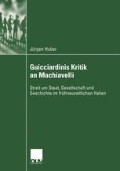Zusammenfassung
Es ist die „Auflösung eines kulturellen Zusammenhangs“ (Burke, 1998), die im frühen 16. Jahrhundert die Blütezeit der „Renaissance“ beendet und in den Wissenschaften und den Künsten, aber auch im täglichen Leben manche Neuorientierung bewirkt. Die sogenannte „wissenschaftliche Revolution“ des 17. Jahrhunderts und der Aufstieg des Barock sind Kennzeichen des Neuen.1
Access this chapter
Tax calculation will be finalised at checkout
Purchases are for personal use only
Preview
Unable to display preview. Download preview PDF.
Rights and permissions
Copyright information
© 2004 Deutscher Universitäts-Verlag/GWV Fachverlage GmbH, Wiesbaden
About this chapter
Cite this chapter
Huber, J. (2004). Fazit und Ausblick. In: Guicciardinis Kritik an Machiavelli. Deutscher Universitätsverlag. https://doi.org/10.1007/978-3-322-81362-6_8
Download citation
DOI: https://doi.org/10.1007/978-3-322-81362-6_8
Publisher Name: Deutscher Universitätsverlag
Print ISBN: 978-3-8244-4603-2
Online ISBN: 978-3-322-81362-6
eBook Packages: Springer Book Archive

